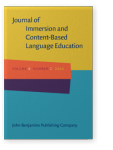Vol. 8:2 (2020) ► pp.149–172
Vol. 8:2 (2020) ► pp.149–172
Building in language support in a Hong Kong CLIL chemistry classroom
An exploratory study
Science writing has played a crucial part in science assessments. This paper reports a study in an area that has received little research attention – how science lessons in content and language integrated learning (CLIL) can increase the science knowledge development of English as a foreign language (EFL) students in Hong Kong. The data come from a school-based interventional study in chemistry classrooms, with written data from questionnaires, assessments and teachers’ logs and verbal data from interviews and classroom observations. The effectiveness of the CLIL teaching and learning activities in various chemistry classrooms were compared and evaluated, with a discussion of some implications. The paper concludes that CLIL teaching and learning activities yielded positive learning outcomes among chemistry learners with low English ability.
Article outline
- 1.Introduction
- 2.Theoretical framework: Teaching and learning cycle
- 3.Literature review
- 3.1Writing in science
- 3.1.1The importance of science writing
- 3.1.2Science knowledge acquisition of EFL students
- 3.2Content and language integrated learning
- 3.3Research gap to be filled
- 3.1Writing in science
- 4.Methodology
- 4.1Research design
- 4.2Research setting and participants
- 4.3Methods of data collection and analysis
- 4.3.1Questionnaires
- 4.3.2Focus group interview
- 4.3.3Observations
- 4.4Research questions
- 4.5Ethical considerations
- 5.Results
- 5.1In the pre-study period
- Results from questionnaires and focus group interviews
- 5.2During the study period
- 5.2.1The MEC
- 5.2.2Student-and-Teacher interactions
- 5.2.3Pre-test
- 5.2.4Post-tests
- 5.3After study period
- 5.3.1Teacher reflection
- 5.1In the pre-study period
- 6.Discussion
- 6.1Teachers’ attitude to CLIL teaching
- 6.2Students’ attitudes to CLIL learning
- 6.3Students’ performance after CLIL learning
- 7.Conclusions and implications
- 7.1Students’ content and language awareness
- 7.2Students’ and Teachers’ acceptance of the CLIL approach
- 7.3Further modifications for the next run
- Modification of the teaching package
- More Emphasis on daily vocabulary and academic vocabulary
- 7.4Further investigations
- Acknowledgements
-
References
